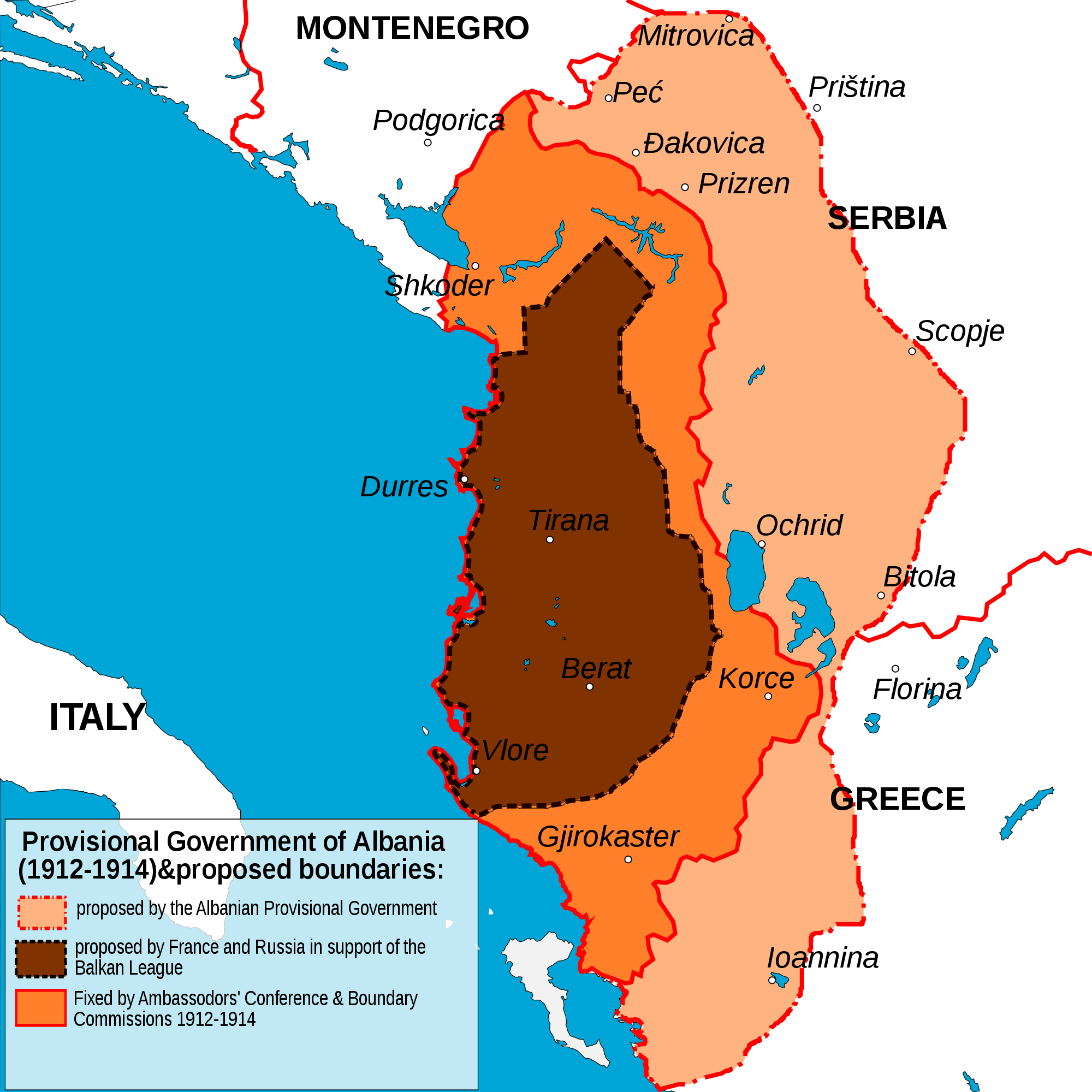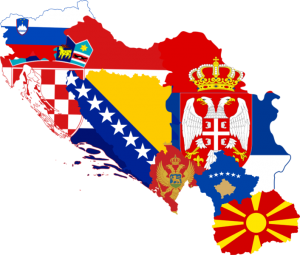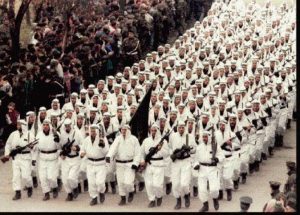
Views: 135
Romantic nationalism and the Balkans
In the 19th century, Europe witnessed the rise of romantic nationalism, which created contemporary nations.[i] Many European states, based on the concept of ethnicity (common origin, culture, history, language, and tradition), were founded at the time, including the people living in the territories of Serbia, Montenegro, Greece, Bulgaria, Croatia, Slovenia, and Romania. However, a number of contemporary regional nations remained at that time without their national states like Slovenians, Croatians, Macedonians, and Albanians. Some of these nations temporarily solved in the 20th century their national aspirations via common states, like Croats, Slovenians, and Macedonians (within several types of Yugoslav political entities).[ii]
The Balkan Albanians, who never had a national state before the 1912−1913 Balkan Wars, started their struggle for the national state rather late, relative to the other nations in the region, for understandable reasons. Unlike other nationalities mentioned, the Albanians had first to forge the concept of the Albanian nation, before attempting to found a national state. Since their Balkan homeland was much retarded in every respect, the initiative for the first stage mentioned came from the Albanians living outside proper Albania. The first concrete action in that direction was made at Prizren, which lies on the traditional Serbian land of Kosovo-Metochia (KosMet) and which at that time was populated with a clear Serbian majority (70%). The so-called First (Albanian Islamic) Prizren League was founded in 1878[iii] in the same year when Serbia, Romania, and Montenegro were definitely recognized by the European Great Powers as the sovereign and independent states at the 1878 Berlin Congress.[iv]
Prizren and the First Albanian League (The League of Prizren)
The question is why the Albanians chose exactly the town of Prizren to organize the first Albanian political league there and to promulgate the first pan-Albanian national program of Greater Albania?
Prizren was not only in Serbia, but it was her capital during the reign of Stefan Dušan, a Serbian King and Emperor (1331−1355).[v] He assumed the title of the Emperor of the Serbs and Greeks and put together a great Serbian Empire which reached from the Mediterranean coast opposite the Island of Lefkada to the River of Danube and controlled the whole of the Bulgarian hinterland.[vi] The geographic location and political, cultural, and ecclesiastical status of Prizren imply that the town was at the core of Serbian territory and even autonomous bishopric territory.[vii] The town of Prizren was mentioned for the first time in the 11th century when the fortress above the town has been erected by the Byzantine authorities. Prizren fell to Bulgarian rule in 1204 and 1282 was included in Serbia (Rascia). The history of the town is closely connected to the personality of Serbian King and Emperor Stefan Dušan Almighty who held court in the town and built a famous Christian Orthodox Church of Ss. Archangels which was later destroyed by Muslim Albanians and Turks who used the material of it to build the Sinan Pasha Mosque in the town. Prizren became occupied by the Ottoman army in 1455 and 1570 became the administrative center of the Ottoman sanjak (administrative unit). From the Ottoman time, a massive influx of neighboring Albanians from North Albania to Prizren and KosMet occurred to such an extent that in the year 1878, there were already 1/3 of the town’s population to be (Muslim) Albanians, the rest the Christian Orthodox Serbs and Roman Catholics. According to the Ottoman census of 1878, the town was populated by 43.922 inhabitants and subsequently making it one of the largest towns in the Ottoman Balkans.
Today, there are three most important cultural-historical buildings in Prizren among others: 1) Serbian Christian Orthodox Church of Bogorodica Ljeviška, built by Serbian King Milutin in 1307−1309 (heavily damaged by Muslim Albanian mob in March 2004); 2) The Sinan Pasha Mosque dating from 1615; and 3) The house of the League of Prizren of 1878 (museum). During the 1998−1999 Kosovo War, Prizren did not suffer the destruction, but, a good part of the town, with its traditional Serb houses in oriental style, was burned down by ethnic Albanians in the summer of 1999 under NATO’s umbrella, and much more have been destroyed by Albanian mob during the organized ethnic cleansing of the Serbs on March 17−19th, 2004, under the very eyes of German Kosovo Force (KFOR) troops.[viii] The Serbs were expelled from Prizren in June 1999 with very few old people left in refuge at the Bogoslovija Orthodox seminary who were later resettled elsewhere, but the house of Bogoslovija was itself burned to the ground by an Albanian fanatic Muslim mob on March 17th, 2004, as was the same with the nearby Serbian Christian Orthodox Monastery of the Holy Archangel Michael. That is the historical destiny of the town of Prizren – “Serbian Constantinople” which according to the Yugoslav census of 1991, had a population of 178.723. Today, there are no Serbs in Prizren.
On June 10th, 1878, Muslim Albanian delegates assembled in Prizren’s mosque for the purpose to work out a common political platform in order to counter both the Russian-Ottoman Treaty of San Stefano signed on March 3rd of the same year and the coming resolutions of the Congress of Berlin (from June 10th to July 10th, 1878), which had with a great reason ignored Muslim Albanian nationalistic claims and wishes to create a Greater Albania in the Balkans. The League initially had full political support from the Ottoman authorities which basically initiated its creation and functioning under the leadership of Albanian public figure Abdul bey Frashëri (1839−1892). The League submitted on June 13th a Memorandum to the British representative at the Congress of Berlin – Benjamin Disraeli. The resolutions of the League (Kararname) have been signed by 47 Muslim Albanian feudal lords (beys) on June 18th, 1878 in which they refused to give up any land to Serbia, Montenegro, and Greece which they assumed to be “Albanian”, demanded the return of all “Albanian” territories annexed by Serbia and Montenegro, required Albanian autonomy within the Ottoman Empire in the form of the creation of united Albanian province composed by for “Albanian” vilayets (a Greater Albania), and, finally, required no more conscription for, and taxation by, the central Ottoman Government in Istanbul.[ix]

After the meeting in Prizren, Abdul bey Frashëri, representing the Central Committee from Istanbul, and a person who had an opening speech at the first meeting of the League of Prizren, returned to South Albania to organize a League Committee and gather Albanian militia to oppose the annexation of this part of Albania by Greece. He as well as traveled to Berlin, Vienna, Rome, and London to seek support for the creation of a Greater Albania according to the resolutions of the League of Prizren. However, the Ottoman Government in April 1881 sent military detachments to pacify the Albanian anti-Ottoman uprising, and as a direct consequence of the intervention, the League was suppressed. Abdul bey Frashëri was arrested by the Ottoman soldiers and later sentenced to life imprisonment but in 1885 he was pardoned. He died in Istanbul after a long illness.[x]
Nevertheless, the League of Prizren has to be considered the formal beginning of the Albanian struggle for the creation of a (Muslim) Greater Albania which was for the first time a project was realized in the practice during WWII by B. Mussolini and A. Hitler and after the 1998−1999 Kosovo War to be in the process of revival under the umbrella of the NATO and the EU.
Peć and the Second Albanian League (The League of Peja)
KosMet is at the center of Serbian national identity, culture, history, and spiritual life for many reasons. The region was in the core of the Serbian medieval state where its capital was in the town of Prizren and the headquarters of an independent Serbian Orthodox Church – the Patriarchate of Peć, located at the mouth of the Gorge Rugova, on the western outskirts of the town of Peć. The monastery, founded on this place in the 13th century at the time of Serbian St. Sava (Rastko) Nemanjić, was the HQ of the Serbian Orthodox Patriarchate from 1346 onward. It is here that the medieval Serbian archbishops and patriarchates lie buried, but, however, in 1455 the Ottoman conquest of KosMet put an end to the power of the Patriarchate of Peć. The patriarchate was not officially abolished, but the power of the Serbian Orthodox Church fell increasingly to the Greek Archbishopric of Ohrid. Nevertheless, the Patriarchate of Peć was restored in 1557 by Sultan’s decree due to the influence of Grand Vizier Mehmed Pasha Sokolović (Islamized ethnic Serbs from East Bosnia) and thereafter managed to exercise its authority over the Serbs within the Balkan provinces of the Ottoman Sultanate.[xi] However, after the First Great Serbian Migration of 1690 from KosMet and Central Serbia under the Patriarch Arsenije III Crnojević (of Montenegrin origin), the Serbian Orthodox Church split into two parts: 1) the Patriarchate of Peć was responsible for the Ottoman Serbs, while 2) newly established Metropolitanate of Sremski Karlovci had jurisdiction over the Habsburg Serbs. Nevertheless, a Greek Patriarch of Constantinople abolished the Patriarchate of Peć on September 11th, 1766, and now no more than a little island of Christian Orthodoxy in a Muslim sea.[xii]
In the garden of the Patriarchate of Peć, there are beautiful and extremely valuable Serbian Christian Orthodox churches, veritable jewels of medieval Serbian art: The Church of the Holy Apostles (about 1253); the Church of St. Demetrius, built by Archbishop Nikodim in 1321−1324; and the Church of the Mother of God (Hodegetria), built by Archbishop Danilo II around 1330. However, according to Albanian Kosovo authorities today, all of, in fact, Serbian Christian Orthodox monuments in KosMet are built by ethnic Albanians or the Byzantine authorities but not by the Serbs. The ethnic Serbs left the town of Peć in June 1999 after the withdrawal of Yugoslav troops according to the Kumanovo Agreement.
The town of Peć (in Albanian, Peja, in Turkish Ipek) is of extreme importance for the Albanian nationalistic ideology and programs regarding the creation of a Greater Albania. The Second Albanian nationalistic organization – The League of Peja was established at a meeting of Albanian leaders (Muslim feudal lords) on January 23−29th, 1899 by the Muslim Albanian cleric and nationalist figure, Haxhi Zeka for the very purpose to recreate and reform the First Albanian League of Prizren (1878−1899). The League of Peja (known as Pledge for a Pledge) was attended by some 500 delegates of whom the biggest number arrived from KosMet, regardless of the very fact that the invitations have been sent to the leaders from all Albanian lands.
There were two crucial political-national aims of the League of Peja:
- The focal purpose of the Albanian League of Peja was to create a „besa“ – a general truce on feuding and warfare so that the Muslim Albanians could direct their national efforts on the creation of a Greater (Muslim) Albania within the Ottoman Empire rather than on fighting among themselves. Such Greater Albania had to be established by allegedly four „Albanian“ vilayets (Ottoman administrative districts) as it was fixed already by the First (Muslim) Albanian League of Prizren in 1878.
- The second purpose was to preserve the Muslim Albanians from the western-oriented Sultan’s reforms, which have been carried out in Istanbul in the favor of the Ottoman Christians and democratic liberalization of the Ottoman Sultanate.
The final program of the League of Peja came out with 12 points for the territorial creation of a Greater Albania within the Ottoman state with an expression of full loyalty to the Ottoman authorities. Nevertheless, the chief message was to preserve Muslim Albanians from Sultan’s pro-western reforms and to guard public order by – and to enforce Sharia Law.
Here, it has to be noticed that since the 1878 League of Prizren onward, any Albanian program on the creation of a Greater Albania was supported by unproven claims that the Albanians are direct descendants of the ancient Balkan Illyrians.
Ex-University Professor
Research Fellow at Centre for Geostrategic Studies
Belgrade, Serbia
www.geostrategy.rs
vsotirovic@yahoo.com
© Vladislav B. Sotirovic 2023
Personal disclaimer: The author writes for this publication in a private capacity which is unrepresentative of anyone or any organization except for his own personal views. Nothing written by the author should ever be conflated with the editorial views or official positions of any other media outlet or institution.
[i] On this issue, see more in [J. G. Fichte, Reden an die Deutsche Nation, Berlin, 1808; F. O. Walzel, German Romanticism, New York: Capricorn Books, 1966; F. Beiser, Enlightenment, Revolution, and Romanticism: The Genesis of Modern German Political Thought, 1790−1800, Mass.: Harvard University Press, 1992].
[ii] On the history of Yugoslavia, see in more detail in [B. Petranović, Istorija Jugoslavije, I−III, Beograd:Nolit, 1988; B. Petranović, M. Zečević, Agonija dve Jugoslavije, Beograd: IKP Zaslon, 1991].
[iii] It was done after a meeting of Albanian leaders in Bajrakli Mosque in Prizren. For the Serbs, Prizren is an “Imperial City” as it was the capital of the 14th century-Serbian Empire. According to historian Peter Bartl, the initiative for the creation of the First Prizren League came from Istanbul Albanians, i.e. from the Central Committee for Defence of the Rights of Albanian Nation [П. Бартл, Албанци од средњег века до данас, Београд: CLIO, 2001, 94]. The League was legally active from 1878 to 1881.
[iv] G. Castellan, History of the Balkans from Mohammed the Conqueror to Stalin, New York: Columbia University Press, 1992, 318−320.
[v] About Stefan Dušan and his Serbian Empire, see in [М. Стевановић, Душаново царство, Београд: Књига-комерц, 2001].
[vi] G. Barraclough (ed.), The Times Atlas of World History, Maplewood, New Jersey, US: Hammond, 141.
[vii] See the map in [A. Galimberti (ed.), Nuovissimo Atlante Storico Mondiale, Milano: Touring Club Italiano, 2001, 40−41].
[viii] R. Elsie, Historical Dictionary of Kosova, Lanham, Maryland‒Toronto‒Oxford: The Scarecrow Press, Inc. 2004, 145; B. V. Jokić (ed.), March Pogrom in Kosovo and Metohija, March 17−19, 2004, with a Survay of Destroyed and Endangered Christian Cultural Heritage, Belgrade: Ministry of Culture of the Republic of Serbia−Museum in Priština (displaced), 2004. About Albanian terror in KosMet after the Kosovo War, see more in [М. Чупић, Отета земља. Косово и Метохија (злочини, прогони, отпори…), Београд. Нолит, 2006; H. Hofbauer, Eksperiment Kosovo: Povratak kolonijalizma, Beograd: Albatros Plus, 2009; П. Пеан, Косово: „Праведни“ рат за стварање мафијашке државе, Београд: Службени гласник, 2013].
[ix] П. Бартл, Албанци од средњег века до данас, Београд: CLIO, 2001, 94−97.
[x] R. Elsie, Historical Dictionary of Kosova, Lanham, Maryland‒Toronto‒Oxford: The Scarecrow Press, Inc. 2004, 60−62.
[xi] В. Ћоровић, Историја Срба, Београд: БИГЗ, 1993, 415−421.
[xii] М. Јовић, К. Радић, Српске земље и владари, Крушевац: Друштво за неговање историјских и уметничких вредности, 1990, 126−146.
Origins of images: Facebook, Twitter, Wikimedia, Wikipedia, Flickr, Google, Imageinjection, Public Domain & Pinterest.
Read our Disclaimer/Legal Statement!
Donate to Support Us
We would like to ask you to consider a small donation to help our team keep working. We accept no advertising and rely only on you, our readers, to keep us digging the truth on history, global politics, and international relations.
FOLLOW US ON OUR SOCIAL PLATFORMS











